Hadar Averbuch-Elor
Cornell University
Not Every Gift Comes in Gold Paper or with a Red Ribbon: Exploring Color Perception in Text-to-Image Models
Aug 27, 2025Abstract:Text-to-image generation has recently seen remarkable success, granting users with the ability to create high-quality images through the use of text. However, contemporary methods face challenges in capturing the precise semantics conveyed by complex multi-object prompts. Consequently, many works have sought to mitigate such semantic misalignments, typically via inference-time schemes that modify the attention layers of the denoising networks. However, prior work has mostly utilized coarse metrics, such as the cosine similarity between text and image CLIP embeddings, or human evaluations, which are challenging to conduct on a larger-scale. In this work, we perform a case study on colors -- a fundamental attribute commonly associated with objects in text prompts, which offer a rich test bed for rigorous evaluation. Our analysis reveals that pretrained models struggle to generate images that faithfully reflect multiple color attributes-far more so than with single-color prompts-and that neither inference-time techniques nor existing editing methods reliably resolve these semantic misalignments. Accordingly, we introduce a dedicated image editing technique, mitigating the issue of multi-object semantic alignment for prompts containing multiple colors. We demonstrate that our approach significantly boosts performance over a wide range of metrics, considering images generated by various text-to-image diffusion-based techniques.
WildCAT3D: Appearance-Aware Multi-View Diffusion in the Wild
Jun 16, 2025Abstract:Despite recent advances in sparse novel view synthesis (NVS) applied to object-centric scenes, scene-level NVS remains a challenge. A central issue is the lack of available clean multi-view training data, beyond manually curated datasets with limited diversity, camera variation, or licensing issues. On the other hand, an abundance of diverse and permissively-licensed data exists in the wild, consisting of scenes with varying appearances (illuminations, transient occlusions, etc.) from sources such as tourist photos. To this end, we present WildCAT3D, a framework for generating novel views of scenes learned from diverse 2D scene image data captured in the wild. We unlock training on these data sources by explicitly modeling global appearance conditions in images, extending the state-of-the-art multi-view diffusion paradigm to learn from scene views of varying appearances. Our trained model generalizes to new scenes at inference time, enabling the generation of multiple consistent novel views. WildCAT3D provides state-of-the-art results on single-view NVS in object- and scene-level settings, while training on strictly less data sources than prior methods. Additionally, it enables novel applications by providing global appearance control during generation.
InstanceGen: Image Generation with Instance-level Instructions
May 08, 2025Abstract:Despite rapid advancements in the capabilities of generative models, pretrained text-to-image models still struggle in capturing the semantics conveyed by complex prompts that compound multiple objects and instance-level attributes. Consequently, we are witnessing growing interests in integrating additional structural constraints, %leveraging additional structural inputs typically in the form of coarse bounding boxes, to better guide the generation process in such challenging cases. In this work, we take the idea of structural guidance a step further by making the observation that contemporary image generation models can directly provide a plausible \emph{fine-grained} structural initialization. We propose a technique that couples this image-based structural guidance with LLM-based instance-level instructions, yielding output images that adhere to all parts of the text prompt, including object counts, instance-level attributes, and spatial relations between instances.
Let it Snow! Animating Static Gaussian Scenes With Dynamic Weather Effects
Apr 07, 2025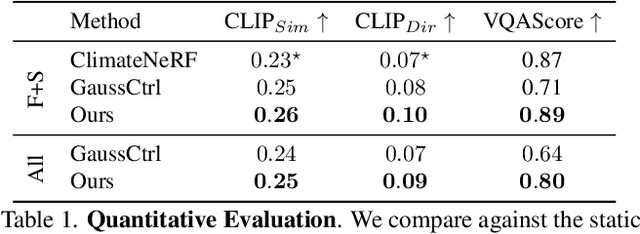
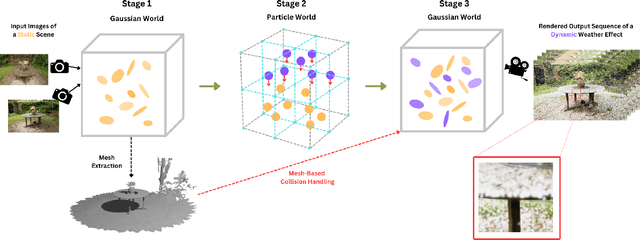
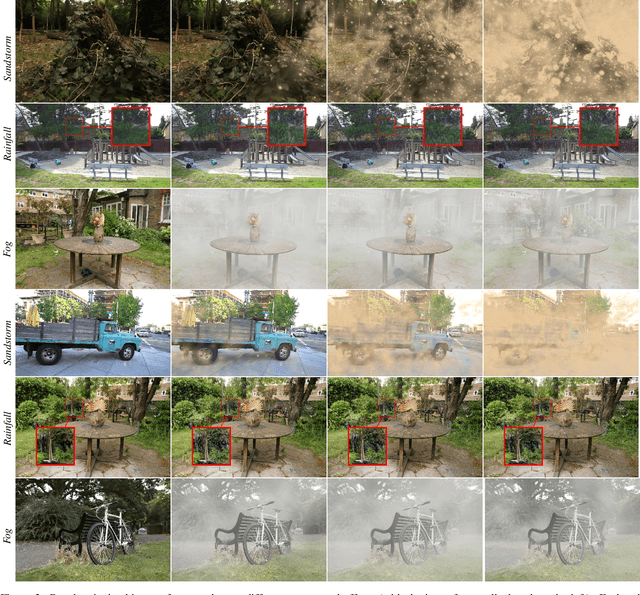
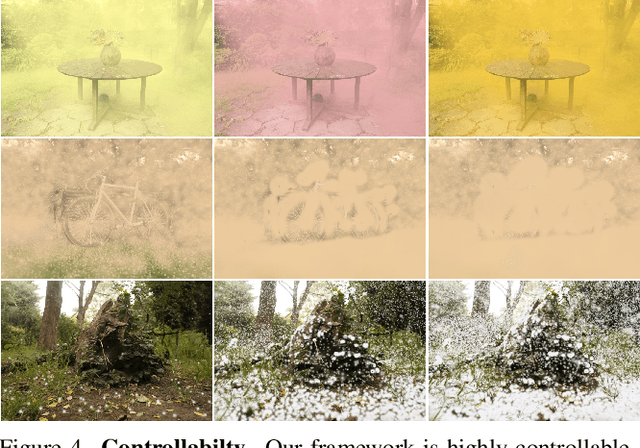
Abstract:3D Gaussian Splatting has recently enabled fast and photorealistic reconstruction of static 3D scenes. However, introducing dynamic elements that interact naturally with such static scenes remains challenging. Accordingly, we present a novel hybrid framework that combines Gaussian-particle representations for incorporating physically-based global weather effects into static 3D Gaussian Splatting scenes, correctly handling the interactions of dynamic elements with the static scene. We follow a three-stage process: we first map static 3D Gaussians to a particle-based representation. We then introduce dynamic particles and simulate their motion using the Material Point Method (MPM). Finally, we map the simulated particles back to the Gaussian domain while introducing appearance parameters tailored for specific effects. To correctly handle the interactions of dynamic elements with the static scene, we introduce specialized collision handling techniques. Our approach supports a variety of weather effects, including snowfall, rainfall, fog, and sandstorms, and can also support falling objects, all with physically plausible motion and appearance. Experiments demonstrate that our method significantly outperforms existing approaches in both visual quality and physical realism.
Dynamic Scene Understanding from Vision-Language Representations
Jan 20, 2025



Abstract:Images depicting complex, dynamic scenes are challenging to parse automatically, requiring both high-level comprehension of the overall situation and fine-grained identification of participating entities and their interactions. Current approaches use distinct methods tailored to sub-tasks such as Situation Recognition and detection of Human-Human and Human-Object Interactions. However, recent advances in image understanding have often leveraged web-scale vision-language (V&L) representations to obviate task-specific engineering. In this work, we propose a framework for dynamic scene understanding tasks by leveraging knowledge from modern, frozen V&L representations. By framing these tasks in a generic manner - as predicting and parsing structured text, or by directly concatenating representations to the input of existing models - we achieve state-of-the-art results while using a minimal number of trainable parameters relative to existing approaches. Moreover, our analysis of dynamic knowledge of these representations shows that recent, more powerful representations effectively encode dynamic scene semantics, making this approach newly possible.
WAFFLE: Multimodal Floorplan Understanding in the Wild
Dec 01, 2024



Abstract:Buildings are a central feature of human culture and are increasingly being analyzed with computational methods. However, recent works on computational building understanding have largely focused on natural imagery of buildings, neglecting the fundamental element defining a building's structure -- its floorplan. Conversely, existing works on floorplan understanding are extremely limited in scope, often focusing on floorplans of a single semantic category and region (e.g. floorplans of apartments from a single country). In this work, we introduce WAFFLE, a novel multimodal floorplan understanding dataset of nearly 20K floorplan images and metadata curated from Internet data spanning diverse building types, locations, and data formats. By using a large language model and multimodal foundation models, we curate and extract semantic information from these images and their accompanying noisy metadata. We show that WAFFLE enables progress on new building understanding tasks, both discriminative and generative, which were not feasible using prior datasets. We will publicly release WAFFLE along with our code and trained models, providing the research community with a new foundation for learning the semantics of buildings.
Extreme Rotation Estimation in the Wild
Nov 12, 2024Abstract:We present a technique and benchmark dataset for estimating the relative 3D orientation between a pair of Internet images captured in an extreme setting, where the images have limited or non-overlapping field of views. Prior work targeting extreme rotation estimation assume constrained 3D environments and emulate perspective images by cropping regions from panoramic views. However, real images captured in the wild are highly diverse, exhibiting variation in both appearance and camera intrinsics. In this work, we propose a Transformer-based method for estimating relative rotations in extreme real-world settings, and contribute the ExtremeLandmarkPairs dataset, assembled from scene-level Internet photo collections. Our evaluation demonstrates that our approach succeeds in estimating the relative rotations in a wide variety of extreme-view Internet image pairs, outperforming various baselines, including dedicated rotation estimation techniques and contemporary 3D reconstruction methods.
4-LEGS: 4D Language Embedded Gaussian Splatting
Oct 15, 2024



Abstract:The emergence of neural representations has revolutionized our means for digitally viewing a wide range of 3D scenes, enabling the synthesis of photorealistic images rendered from novel views. Recently, several techniques have been proposed for connecting these low-level representations with the high-level semantics understanding embodied within the scene. These methods elevate the rich semantic understanding from 2D imagery to 3D representations, distilling high-dimensional spatial features onto 3D space. In our work, we are interested in connecting language with a dynamic modeling of the world. We show how to lift spatio-temporal features to a 4D representation based on 3D Gaussian Splatting. This enables an interactive interface where the user can spatiotemporally localize events in the video from text prompts. We demonstrate our system on public 3D video datasets of people and animals performing various actions.
Emergent Visual-Semantic Hierarchies in Image-Text Representations
Jul 11, 2024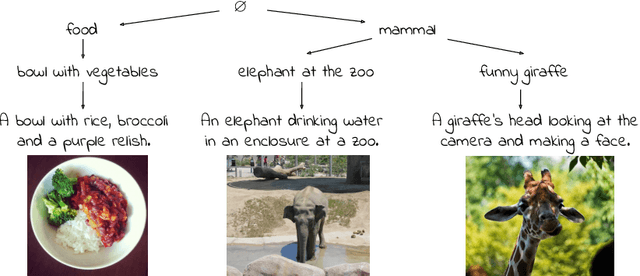
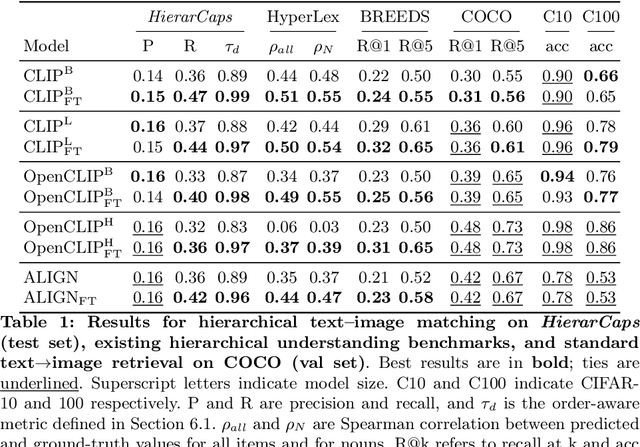

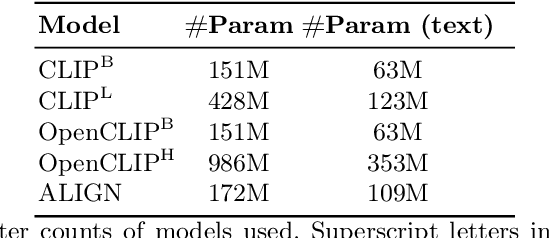
Abstract:While recent vision-and-language models (VLMs) like CLIP are a powerful tool for analyzing text and images in a shared semantic space, they do not explicitly model the hierarchical nature of the set of texts which may describe an image. Conversely, existing multimodal hierarchical representation learning methods require costly training from scratch, failing to leverage the knowledge encoded by state-of-the-art multimodal foundation models. In this work, we study the knowledge of existing foundation models, finding that they exhibit emergent understanding of visual-semantic hierarchies despite not being directly trained for this purpose. We propose the Radial Embedding (RE) framework for probing and optimizing hierarchical understanding, and contribute the HierarCaps dataset, a benchmark facilitating the study of hierarchical knowledge in image--text representations, constructed automatically via large language models. Our results show that foundation VLMs exhibit zero-shot hierarchical understanding, surpassing the performance of prior models explicitly designed for this purpose. Furthermore, we show that foundation models may be better aligned to hierarchical reasoning via a text-only fine-tuning phase, while retaining pretraining knowledge.
ReNoise: Real Image Inversion Through Iterative Noising
Mar 21, 2024Abstract:Recent advancements in text-guided diffusion models have unlocked powerful image manipulation capabilities. However, applying these methods to real images necessitates the inversion of the images into the domain of the pretrained diffusion model. Achieving faithful inversion remains a challenge, particularly for more recent models trained to generate images with a small number of denoising steps. In this work, we introduce an inversion method with a high quality-to-operation ratio, enhancing reconstruction accuracy without increasing the number of operations. Building on reversing the diffusion sampling process, our method employs an iterative renoising mechanism at each inversion sampling step. This mechanism refines the approximation of a predicted point along the forward diffusion trajectory, by iteratively applying the pretrained diffusion model, and averaging these predictions. We evaluate the performance of our ReNoise technique using various sampling algorithms and models, including recent accelerated diffusion models. Through comprehensive evaluations and comparisons, we show its effectiveness in terms of both accuracy and speed. Furthermore, we confirm that our method preserves editability by demonstrating text-driven image editing on real images.
 Add to Chrome
Add to Chrome Add to Firefox
Add to Firefox Add to Edge
Add to Edge